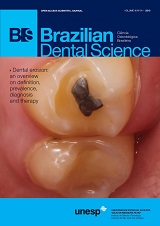A Critical Review on the Conversion Degree of Resin Monomers by Direct Analyses
DOI:
https://doi.org/10.14295/bds.2013.v16i1.845Abstract
Abstract
Objectives: The aim of this study was to carry out a review on the methods of direct detection of composite resins´ degree of conversion.
Data/sources: The authors searched the Cochrane Library, Embase, PubMed, and the Web of Science (ISI) for papers dated from January 1991 to November 2011. The search was complemented by manual searches of the reference lists from each identified relevant paper. The main search terms were: “degree of conversion”, “monomers”, “polymers”, “composite”, “pre-gel”, “post-gel”, “residual monomers” and “double bond”.
Study selection: The inclusion criteria were studies that evaluated consolidated methods in the literature to directly evaluate the degree of conversion. Excluded studies were those considered to be unrelated to the question addressed, such as mechanical and physical properties and also monomers from adhesive systems and compomers. The selected papers were assigned to a score (A, B or C), according to the predetermined criteria. A total of 45 papers were selected and 15 papers were included in the critical appraisal. Two articles were labeled as grade A, nine articles were labeled as grade B, and four articles were labeled as grade C.
Conclusions: According to the definitions of evidence levels, the current article study showed a strong evidence of review.
Clinical significance: The monomer´s degree of conversion predicts the quality of polymers.Downloads
Downloads
Additional Files
Published
How to Cite
Issue
Section
License
Brazilian Dental Science uses the Creative Commons (CC-BY 4.0) license, thus preserving the integrity of articles in an open access environment. The journal allows the author to retain publishing rights without restrictions.
=================




























